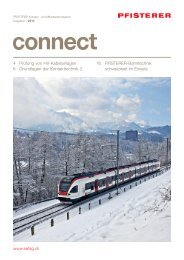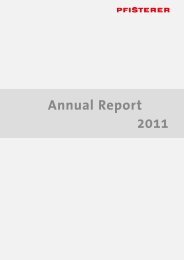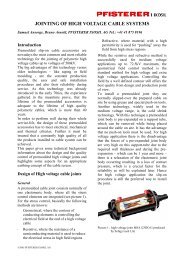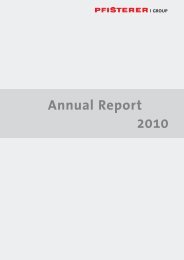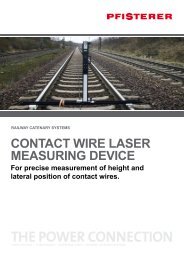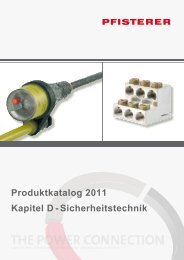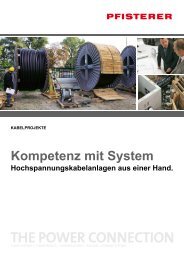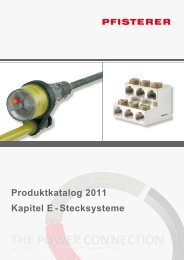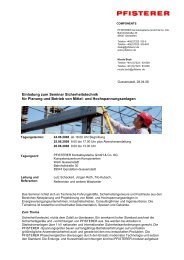Bending of helically twisted cables under variable ... - Pfisterer
Bending of helically twisted cables under variable ... - Pfisterer
Bending of helically twisted cables under variable ... - Pfisterer
You also want an ePaper? Increase the reach of your titles
YUMPU automatically turns print PDFs into web optimized ePapers that Google loves.
Summary<br />
The bending <strong>of</strong> <strong>helically</strong> <strong>twisted</strong> cable is a severe loading case for these important structural<br />
components. During bending <strong>of</strong> such <strong>cables</strong>, slippage takes place between the individual wires <strong>of</strong> the<br />
cable, which is greatly influenced by the frictional forces acting at the inter-wire contacts. Because <strong>of</strong><br />
this slippage, the cross-sections <strong>of</strong> the cable do not necessarily remain plane, which has to be<br />
considered in the formulation <strong>of</strong> the bending stiffness <strong>of</strong> the cable.<br />
The main subject <strong>of</strong> this work is to develop, based on generally accepted principles for bending <strong>of</strong><br />
<strong>cables</strong>, an adequate model to quantify the bending behaviour <strong>of</strong> multilayered <strong>helically</strong> <strong>twisted</strong> <strong>cables</strong>.<br />
This model leads, <strong>under</strong> consideration <strong>of</strong> internal friction, to a <strong>variable</strong> effective bending stiffness which<br />
depends on the cable curvature and the tensile load acting on the cable. With this information it is now<br />
possible to calculate the deflection, curvature and the various components <strong>of</strong> stress in the wires <strong>of</strong> the<br />
cable analytically. With the newly developed “cable scanner”, the catenary and curvature <strong>of</strong> the cable<br />
axis can be determined by scanning the cable surface. The agreement between theory and<br />
measurement is quite good.<br />
The model is extended to cover also ACSR (Aluminium conductor, steel reinforced), a conductor which<br />
is widely used in overhead transmission lines, and is validated through corresponding measurements.<br />
An important application <strong>of</strong> this work is the calculation <strong>of</strong> dynamic bending stresses in the individual<br />
wires <strong>of</strong> such conductors, <strong>under</strong> wind induced (aeolian) vibrations. These calculations consider the<br />
ordinary alternating bending stresses plus the secondary tensile stresses (“zusatz” stresses) caused by<br />
interlayer friction between wires, which together constitute the longitudinal fatigue stress. The theory<br />
resolves a known discrepancy between measured stresses and stresses predicted by simpler<br />
conductor models in use today, which assume a constant bending stiffness. It also settles the long<br />
outstanding uncertainty on the proper choice <strong>of</strong> effective bending stiffness for vibrating conductors. This<br />
opens up a new way <strong>of</strong> determining the stress limits for such conductors <strong>under</strong> vibrating conditions.



